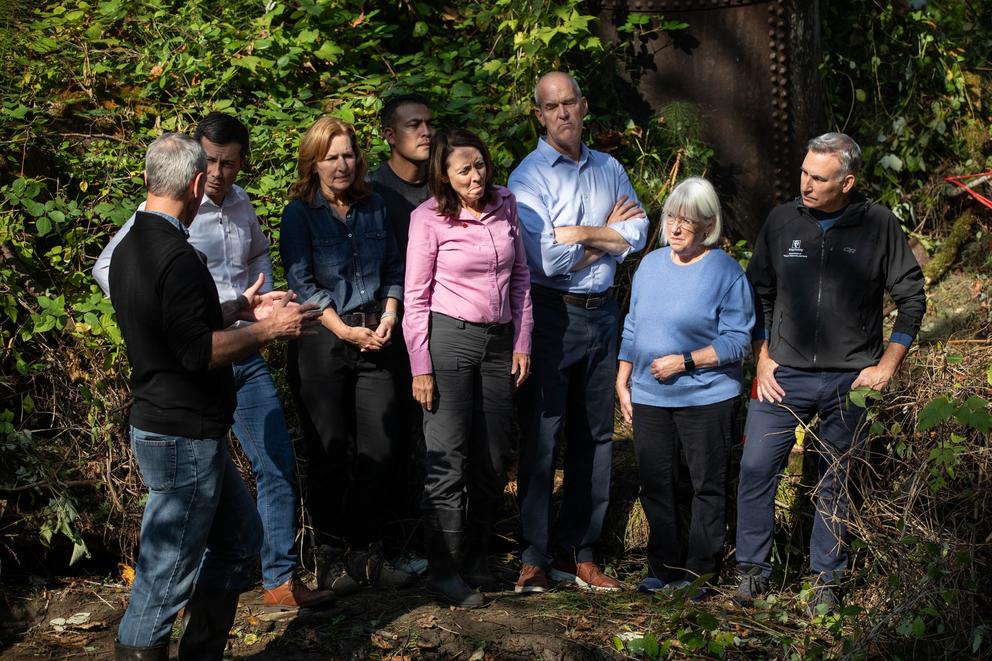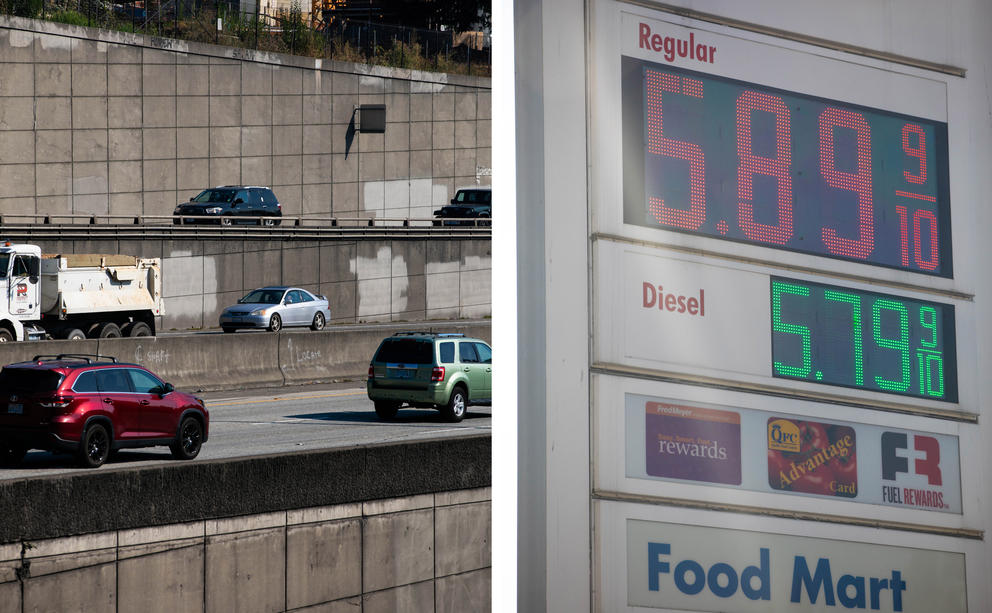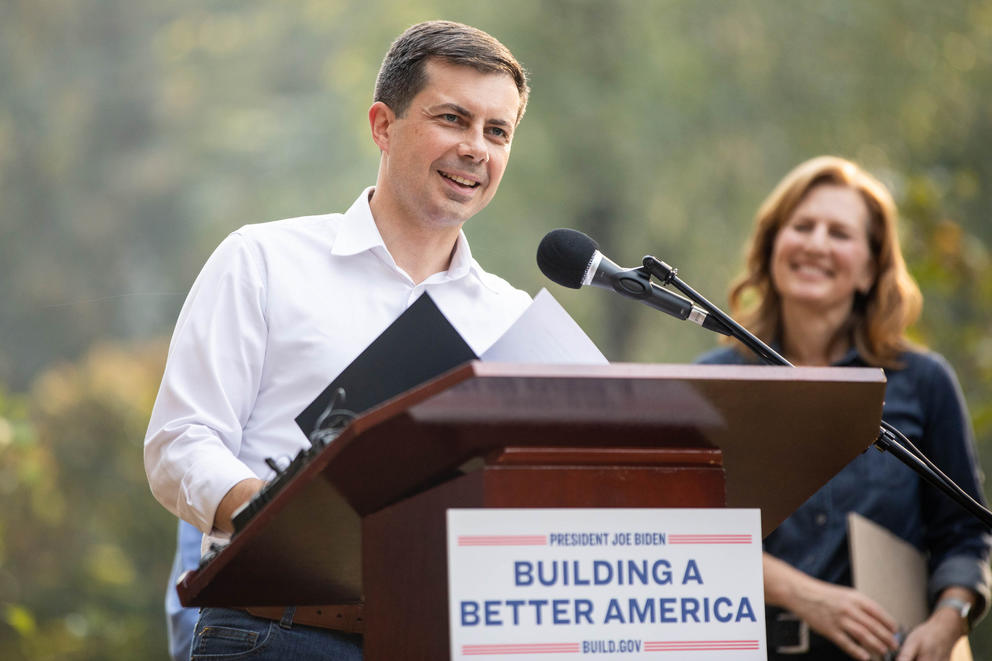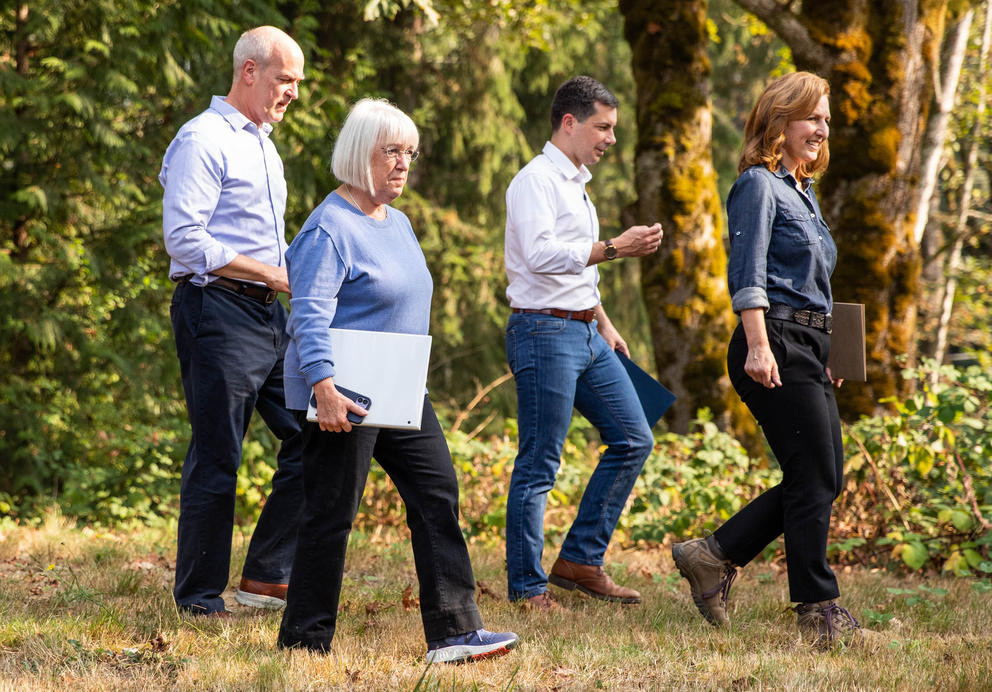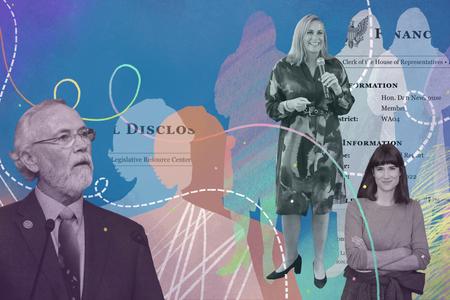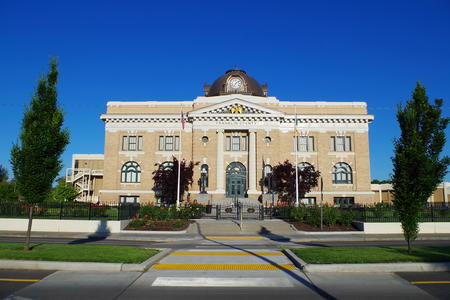“Inflation is reaching record levels,” a narrator bemoans. “We can’t afford to fill up our cars with gas. We can’t afford groceries.”
This dramatization is brought to you by the campaign of Matt Larkin, a Republican running to unseat Democratic Rep. Kim Schrier in Washington’s 8th Congressional District. Larkin, who did not respond to multiple interview requests, has embraced a conservative playbook that blames kitchen table economic woes on sweeping federal investments enacted by Democrats. A similar Larkin ad casts inflation as the third in a triptych of antagonists alongside “crime” and the “southern border.”
A recent analysis of pro-Republican ads found nearly half mentioned inflation.
This line of attack comes as Democrats have advanced a vision of the federal government playing a robust role in the economy, pumping billions of dollars of emergency pandemic aid into local governments and schools — but also passing more forward-looking spending packages for transportation, policing, health care and green energy.
“These were investments that kept our small businesses afloat, that got vaccines into arms across this country… that kept families afloat,” Schrier said in an interview with Crosscut. “It rescued our economy, and that is what it was designed to do.”
Experts say conflicting economic indicators allow both parties to cherry-pick talking points in their efforts to spin federal investments as either runaway spending that has overheated the market or a strategic inoculation against recession. (Many economists agree federal relief played a modest role in driving inflation, alongside global supply chain interruptions and other issues.)
Despite the muddy economic outlook, some Democrats have continued to tout the impact of their historic spending bills. Others, though, have pivoted away from the economy to culture war issues they hope will reliably mobilize voters. Republicans, meanwhile, have often campaigned against federal spending despite voting for COVID-19 aid under former President Donald Trump or benefiting locally from recovery dollars.
Recent polling has shown that economic concerns remain a priority for many voters. How candidates talk about the economy, then, is likely to have real ramifications for the balance of power in Washington, D.C. The results on Nov. 8 may say less about the state of the economy than the stories voters want to believe.
Left: Vehicles drive along Interstate 5 on Monday, Oct. 3, 2022. President Biden and Democrats have been funding highway expansions and bridge repairs through the bipartisan Infrastructure Law, but most projects are still in their early stages. Right: Gas prices listed at a Shell station in Greenwood on Monday, Oct. 3, 2022. After gas prices peaked in June, they have started to climb back up in October. The average gas price in Washington is $5.38, according to AAA. (Amanda Snyder/Crosscut)
Responding to COVID-19
During the COVID-19 shutdown in 2020, Congress found rare bipartisan buy-in on the need for a government response. Public CNBC polling from July 2020 found broad support for relief efforts like direct stimulus checks to households (80%), aid to local governments (68%) and enhanced unemployment benefits (62%).
Those measures remained popular even as attitudes toward federal spending hardened among Republicans in Congress after President Joe Biden took office. A March 2021 survey conducted by the Pew Research Center found that 70% of respondents supported the American Rescue Plan Act (ARPA), including 41% of people who identified as Republican or Republican-leaning. Biden’s $1.9 trillion relief package, then under consideration, extended and expanded those emergency supports.
But ARPA did not get a single vote from Republicans in Congress, many of whom had supported two previous relief packages passed under Trump. They decried Biden’s intervention as too sweeping, too expensive and inclusive of broader anti-poverty programs that weren’t specifically tailored to pandemic recovery. Just 13 House Republicans signed on to the subsequent Infrastructure Investment and Jobs Act (IIJA).
Democrats have since credited these interventions for a faster-than-expected economic rebound — by August 2021, unemployment was down to 5% from a pandemic peak of nearly 15% — casting the recovery as being buoyed by a strong state response.
This story is a part of Crosscut’s WA Recovery Watch, an investigative project tracking federal dollars in Washington state.
In an interview with Crosscut last month, U.S. Sen. Patty Murray, D-WA, described ARPA as “critical to get schools reopened and students back in classrooms, shots into arms,” adding the relief “helped our state and tribal and local governments get back on their feet, helped police and first responders.”
Democrats have issued myriad news releases and toured the country touting infrastructure investments. Several joined Transportation Secretary Pete Buttigieg last week as he visited a culvert near Maple Valley to announce a $1 billion grant program for fish-passage projects.
But high inflation and shortages of things like cars and microchips continue to blur the economic picture. Murray’s opponent Tiffany Smiley, who faces an uphill battle against the five-term incumbent, seized on prices as an opportunity to portray the economy as troubled more broadly.
“From skyrocketing inflation to an ongoing recession, our economy is going in the wrong direction,” reads Smiley’s website. (Smiley’s press team declined to make anyone available to discuss their messaging around federal spending.)
Caleb Heimlich, chair of the Washington State Republican Party, echoed the idea that Republicans’ strongest selling point on the economy is pinning negative indicators like inflation on Democratic policies. Heimlich allowed that some Democratic initiatives were helpful, but added that the totality of the spending went overboard.
“Republicans certainly aren’t against investments in freeways, investments in schools, and investments in public safety,” Heimlich said. “I think it’s a more measured approach to saying where we’re at right now with an economy that’s teetering on the brink of a recession. … We should be prioritizing things and trying to do less harm.”
Fact check: Did relief spending cause inflation?
While competing indicators can make parsing the state of the economy confusing, many economists stop short of the GOP’s dire assessment. That’s because recessions are typically identified in retrospect, and are rarely accompanied by 3.7% unemployment and continued job growth.
Though inflation can indicate trouble ahead, most economists — even those who oppose Biden’s economic policies — say inflation stems from a multitude of causes, including pandemic-induced supply chain shortages, boycotts of Russian oil, and soaring rent prices.
Federal stimulus packages, which include not just the American Rescue Plan, but also the $2.2 trillion CARES Act and the $900 billion Coronavirus Response and Relief Supplemental Appropriations Act — both passed in 2020 while Trump was President — do play a role in inflation, said Dean Baker, senior economist at the left-leaning Center for Economic and Policy Research.
Baker estimates pandemic stimulus aid added 1 or 2 percentage points to inflation, which has hovered around 8% for much of this year (meaning goods cost 8% more than they did one year prior). He reasons that’s how much higher U.S. inflation rates were in 2021 than European countries — which tended to opt for smaller stimulus packages. (Inflation rates in some European countries have since caught up or even surpassed the U.S. since Russia invaded Ukraine.)
“I’m sure you’ll find people who come up with a higher number,” Baker said, “but even people who are big inflation hawks, they don’t attribute most of the inflation to the [American Rescue Plan] Act.”
Douglas Holtz-Eakin, president of the right-leaning think tank American Action Forum, said he believes the American Rescue Plan was much larger than necessary and “full of things that have nothing to do with the problem” of bringing the economy back from COVID-19.
But he largely echoed Baker’s analysis on inflation. Holtz-Eakin cited a study by the Federal Reserve Bank of San Francisco that estimated demand-side policies (giving people money to buy things with) drove about one-third of current inflation, slightly higher than Baker’s tally.
“It’s not all of the inflation but [it’s] certainly some of it,” Holtz-Eakin said.
Find tools and resources in Crosscut’s Follow the Funds guide to track down federal recovery spending in your community.
As far as the rest of the Democrats’ legislative record, it’s unlikely that infrastructure spending had much of an effect on inflation, Baker said, because much of it has yet to materialize into active construction projects that would have cascading economic impacts.
And the recently passed climate and healthcare law — though it may not reduce inflation — is predicted to cut the deficit, according to a Congressional Budget Office estimate. The spending is offset by new revenue from a 15% minimum tax on corporations making over $1 billion and allowing Medicare to negotiate prescription drug prices.
Schrier doesn’t deny that inflation has hurt household pocketbooks, but she said she’s introduced policies to ease supply chain blockages and limit price-gouging by fuel companies. As far as actively cutting spending, Schrier dismissed Heimlich’s assertion that it would be the best way to cull inflation, adding that some Republicans have cited Social Security as a place to cut spending.
“That’s not a plan that helps families in the 8th District,” Schrier said.
Spending as a culture war issue
In a recent Crosscut/Elway poll of likely Washington voters, those who identified as Republicans were three times as likely to report the economy as a top concern. Meanwhile, Democratic-identified voters were nearly seven times as likely to list abortion as a major issue. As Election Day nears, both parties have leaned into those priorities, which they view as winning issues, respectively.
The Republican messaging against “wasteful spending” has put some in the position of opposing federal economic stimulus programs broadly, even voting against significant increases in federal dollars for their home districts.
Rep. Cathy McMorris Rodgers of Eastern Washington supported relief efforts under Trump, but has since voted against even routine government funding. She was the only Washington Republican to oppose the Consolidated Appropriations Act, a bipartisan effort which garnered 155 Republican votes in March. Notably, it included $22 million in projects proposed by her office – the second-highest earmark total of any representative in the state, according to a New York Times analysis.
McMorris Rodgers told Crosscut she voted against the annual budget bill because the price tag was too high – but was unable to point to any specific provisions she opposed.
“I have concerns about the overall increase in spending, record increases in spending that we are seeing from this administration,” McMorris Rodgers said, before pivoting to a criticism of a different bill, the Inflation Reduction Act.
McMorris Rodgers has also escalated her opposition to federal spending in the year since Spokane County hired her brother, Jeff McMorris, to oversee the distribution of more than $100 million in American Rescue Plan money. She said her brother’s experience has not influenced her view of ARPA, calling it “not COVID relief, but just more spending.”
Despite the characterization of ARPA as big-government bloat muscled through on a party-line vote, Republican officials have overseen much of the spending at the local level. Police and jails have been some of the major beneficiaries of ARPA dollars, both in Washington and nationally.
In contrast to Larkin’s inflation ads, Schrier has positioned federal investments in services and infrastructure as bipartisan victories, touting buy-in from local Republicans and highlighting police spending. But other Democrats, such as Murray, have recently sought to reinforce their legislative achievements with appeals to key social issues like abortion access or voting rights.
Travis Ridout, a political advertising researcher at Washington State University, said the hardline positions being dug out on federal spending – even among representatives who benefit from it – partly reflect broader partisan divides.
Campaigning on local issues and bringing resources back to a district may have worked years ago, but gerrymandering has resulted in fewer truly competitive districts, meaning that boosting turnout among the party’s base often matters more than peeling off theoretical swing voters. And that means playing to hot-button national issues.
“It means talking about abortion or the ‘scourge’ of immigration or whatever it is, as opposed to, I brought price supports for farmers in our district, or I got this road repaved,” Ridout said. “If all I need to do is make sure that my people show up to vote, then maybe it doesn’t make sense to talk about actually passing legislation. Maybe I just need to make people mad.”

